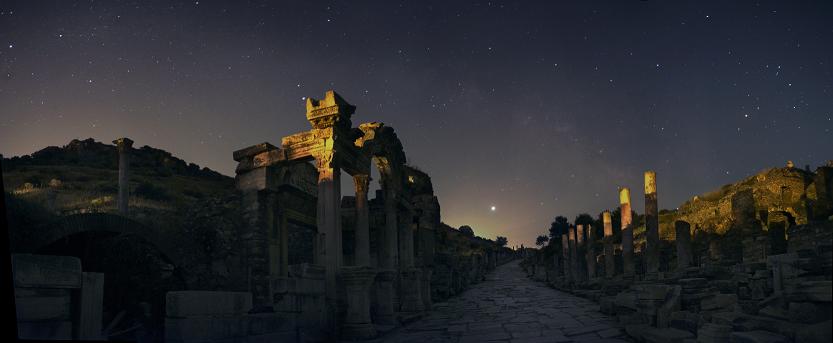
SAINT OF THE DAY
The Lives of the Saints, Martyrs, Exemplars and Prophets of ANTINOUS the GAY GOD
Updated for Each Liturgical Feast Day
By
Antonyus Subia and Hernestus Gill
Priests of Antinous
APRIL 1st

SAINT OF THE DAY
The Lives of the Saints, Martyrs, Exemplars and Prophets of ANTINOUS the GAY GOD
Updated for Each Liturgical Feast Day
By
Antonyus Subia and Hernestus Gill
Priests of Antinous
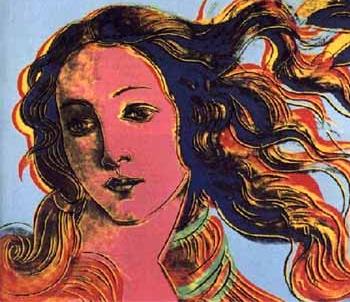
On April 1st the Religion of Antinous celebrates THE VENERALIA, the birth of Venus Urania.
When Saturn castrated his father Uranus, and separated the sky from the earth, by cutting away the testicles of heaven, Venus, the Great Goddess of Love was born, where the foam of the testicles washed ashore on the island of Cypress.
She was attended by the Erotes, the spirits of desire, and soon created the Graces.
She was brought into Olympus by marrying Vulcan, the smith god, but Venus is an older, and more powerful than the Olympians, except for Zeus, because she is directly descended from Uranus, the heavens.
Venus shared her love with almost all the gods, to the humiliation of Vulcan, Juno's son, but her most ardent desire was for the war god Mars, whose virile masculinity is in direct contrast to her voluptuous feminine grace.
Together Mars and Venus fought for the Trojans against the other jealous goddesses, and though Zeus gave victory to the Greeks, he promised Venus that her chosen people would have their revenge.
So it was that Venus guided her son Aeneus and his followers out of the burning city and across the world to the place where Rome would one day stand. The descendants of the Trojan refugees, and of Mars, were Romulus and Remus who founded Rome, whose sons, through War and Love would conquer the world.
Julius Caesar claimed to be descended from Venus through Aeneus, and so she became the guardian spirit of the Emperors. In the year 135 Hadrian dedication of the Temple of Venus and Roma.
Hadrian built one of the largest Temples in Rome for the Great Goddess of Love and for the Spirit of the Deified City. Hadrian intended with this Temple to proclaim to the Romans that the Empire was the child of Love and War, but that Love, through the Goddess Venus, was to be the foremost power. We dedicate this day to Venus Urania, who blesses homosexual love.
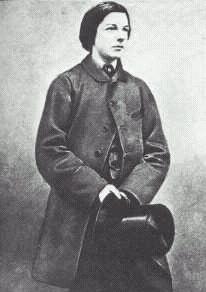
On April 8th the Religion of Antinous honors St. John Addington Symonds, the English poet and literary scholar who shocked Victorian sensibilities by openly promoting the cause of same-sex love.
John Addington Symonds was born on 5 October 1840, to a wealthy middle-class family in Bristol England. His father was a liberally minded doctor with connections and close friendships with many of the most illustrious and forwards minds of the time.
It was this environment of Victorian middle-class sexual repression that caused John Addington Symonds to blossom into one of the first and most prolific proponents for the cause of love between men.
While teenager in school, he was awakened by Plato to the awareness of love between boys among his schoolmates and almost immediately and unhesitatingly came out of the closet, even to his father, who was initially dismayed but ultimately supportive.
From then on, Symonds devoted his entire life to the study of homosexuality through art and history. He was the most pronounced defender of the ancient and glorious legacy of love between men, and a champion of social change.
He was a deep admirer of Walt Whitman, and later worked closely with Edward Carpenter, and Dr. Magnus Hirschfeld, co-founding the British Institute for Sexual Science, which advocated a methodical study to overturn the laws against homosexual love.
For his life-long work and devotion, and for his early recognition and exultation of his sexuality, John Addington Symonds is a canonized Saint of the Religion of Antinous.
The most sacred of his many contributions to the enlightenment of our freedom are the words that he wrote about Antinous, whose beauty he glorified with poetry and elegance in the language of a lover of the homosexual, erotic beauty of Our God. John Addington Symonds died in Rome on the 8th of April 1893.
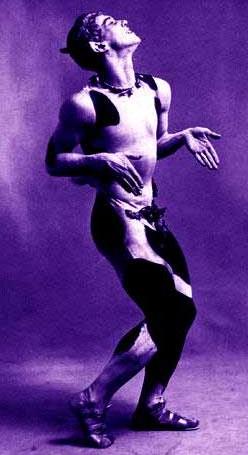
On April 8th the Religion of Antinous honors St. Vaslav Nijinsky, the greatest gay ballet dancer/choreographer of all time, who died on this day in 1950 in an insane asylum.
He was a living Antinous who innately understood our religion's idea of Homotheosis -- Gay-Man-Godliness-Becoming-the-Same.
Homotheosis can only be accomplished by a self-inflicted act of faith after the example of Antinous. One must deny this mortal existence of death and decay, which existence is rightfully called transient, and cast the mortal self into the rushing waters of the Nile that flows within the veins and arteries of our true, perfect, interior self. A body that is the same as and as beautiful as the marble flesh of Antinous the Gay God. This is not turning away from life, but turning to it for the very first time, and finding the light of the Unconquered Sun that has always shone within.
One of this religion's favorite Hadrian and Antinous stories is the tumultuous love affair between Vaslav Nijinsky and Sergei Diaghilev. Nijinsky completely changed ballet, inventing what we now consider to be modern dance. Of course he was out of his mind, and after his relationship with Diaghilev ended, he went certifiably insane and spent the rest of his life in an asylum.
Vaslav Fomich Nijinsky was born in Kiev on March 12th, 1888. Both his parents were ballet dancers, and Vaslav was introduced to the stage as a child. When he was a 18 he became the lover of Prince Paul Dmitrievitch who then introduced him to Sergei Diaghilev, the ballet impresario, whose lover he became in 1908.
Diaghilev took Vaslav to Paris where he was starting the famous Ballet Russe, an experimental production company that brought together the finest composers of the day with the most innovative scenery artists, costumers, and of course the greatest ballet dancers in the world.
The volatile relationship between the teenage Nijinsky and the 40-year-old Diaghilev led to the some of ballet's most profound and moving works. Nijinsky was the male star of the Ballet Russe, but he soon showed that his true talent lay in choreography. His debut as a choreographer came when he was 21 in the short piece entitled "L'apr?s-midi d'un Faune" (Prelude to the Afternoon of a Fawn) with music by Claude Debussy, in which Nijinsky starred as the lustful faun trying in vain to seduce a group of nymphs.
The ballet caused a scandal when it premiered in Paris in May 1912 because of the highly suggestive ending in which Nijinsky pantomimed masturbation and orgasm.
But that was nothing compared to the riots that broke out after his next choreography for the orgiastic Le Sacre du printemps (The Rite of Spring).
The style of Vaslav Nijinsky was far ahead of his day. He revolutionized the ballet and single-handedly invented what we call modern dance, rejecting the stylistic forms passed down by tradition in favor of sensuality, odd gestures and unnatural movement that was totally infused with the grace and power of the feel of music.
The relationship between Nijinsky and Diaghilev broke down over time and they separated. Nijinsky married a female fan he had only met once ? simply to spite Diaghilev. But he was slowly succumbing to mental illness, and would eventually lose his mind completely.

He wrote a bizarre diary in the few weeks before he was taken away to spend the rest of his life in various mental institutions. The genius of Vaslav Nijinsky, who was taken as a stupid person because of his shy and quiet demeanor, was revealed in his divine power of dance and in the sublimity of his strange diary.
Here is an excerpt, you'll notice the way that he rambles just barely able to communicate his wandering mind. Nijinsky was already leaving this world and becoming an immortal. He signed the last page, Nijinsky, the God.
"One day in the streets of Paris I pushed [Diaghelev] in order to show him that I was not afraid of him. Diaghelev hit me with his stick, as I wanted to go away from him. After this we lived for a long time together. I loved the Ballets Russes. I gave my whole heart to it. I worked like an ox. I lived like a martyr. I lived sadly and sorrowed alone. I wept alone. I loved my mother and wrote her letters every day. I was afraid of life, because I was very young. I could not go on composing the ballet 'Jeux.' It was a ballet about flirting and unsuccessful, as I had not feeling for it. The story of this ballet is about three young men making love to each other. I began to understand life when I was 22 years old. I composed this ballet alone, too. Debussy, the well-known composer, wanted the subject to be written down.
"Diaghelev likes to say that he created the ballet, because he likes to be praised. I do not mind if Diaghelev says that he composed the stories of 'Faune' and 'Jeux,' because when I created them, I was under the influence of 'my life' with Diaghelev. The Faune is me and Jeux is the life which Diaghelev dreamed. Diaghelev wanted to make love to two boys at the same time and wanted these boys to make love to him. In the ballet, the two girls represent the two boys, and the young man is Diaghelev. I changed the characters, as love between three men could not be represented on the stage'"
The Parisians called him the God of Dance, and toward the end of his diary, he signed his name, Nijinsky, the God. He died in a London clinic on April 8, 1950.
We consecrate him as a Saint and as a living incarnation of Antinous/Pan/Dionysus. St. Vaslav Nijinsky, who knew how to live Homotheosis every single blessed day of his life -- which means living daily the Divine Spirit of Being Gay -- and who knew how to express this ineffable spirit in dance as well.
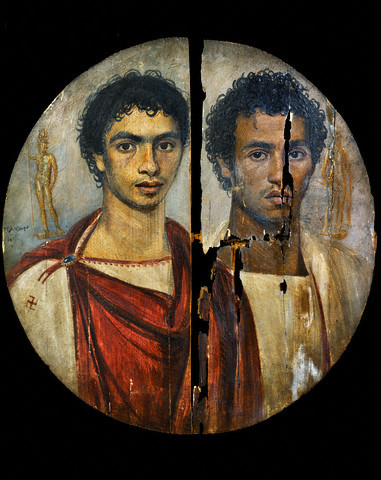
On April 10th the Religion of Antinous honors St. Apollonius and St. Philemon of Antinoopolis, two loving friends who died together as martyrs to religious persecution.
The Sacred City of Antinoopolis was built upon the bank where Antinous had fallen into the Nile. From its birth the city was enshrouded with the specter of death.
The Religion of Antinous under the Curia of Antinoopolis was a death cult. The city's two major temples, that of the Egyptian faction and the larger Antineion which is the second possible site of the Lost Tomb of Antinous, were places for the perpetual lamentation of the death of Antinous, and for the passing of all beauty and youth in the world.
Antinoopolis was the flower of Greek civilization deep in the desert of the Thebaid, and it was a haven for dispossessed and exiled thinkers and theological revolutionaries of all sorts. But there came a time when even liberal-minded Antinoopolis fell under the sway of the fear and violence that had swept across the world.
The Christian faith was suffering one of the bloodiest persecutions in its history. In the 4th Century CE, as Antinoopolis was in full flower, Emperor Diocletian had sought to curb the rising tide of Christianity with brutal violence. He issued decrees that all citizens should be compelled to demonstrate their piety to the Roman Gods by offering sacrifice. It was a direct challenge.
Any person who refused was not only insulting the Gods of Rome, but also showing disloyalty to the Emperor and to Rome herself. Such treason was punishable by death. This was a legal way to persecute Christians. It was not an attack on the Christian doctrine, or its practices, but demonstrated an unavoidable line that no Christian would cross.
It is interesting to note that, although many of the Christians were executed by beheading or by being shot through with arrows, some were executed by being drowned in the Nile. This similarity between their deaths and the death of Antinous must have been very moving to the Ancient Priests of Antinous.
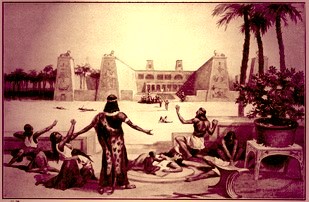
And it is also curious that the authorities apparently were not sensitive to the nature of this form of execution in the sacred city of a boy who had become a god simply by drowning in the Nile.
Of these Martyrs, the most profoundly moving are Apollonius and Philemon. Philemon was a Deacon of the Church, also called a reader. The story goes that he was ordered to make a pagan sacrifice at Antinoopolis in order to prove that he was not a practicing Christian. He couldn't bring himself to do that, so he asked his "dearest friend" Philemon to make the sacrifice for him, since Philemon was a pagan.
Philemon is said to have been a flute player, an occupation notoriously held by homosexuals. While one was a young Christian priest and the other a pagan, it is indeed noteworthy that Apollonius the priest would have the confidence and trust to ask Philemon to take his place, and that Philemon would risk his life to aid the young priest. The two must have had a very close friendship, the nature of which has escaped the attention of the Christian martyrologists.
In the end, of course, the ruse was found out and they both died together by being drowned after the manner of Antinous, in the Nile.
One key element of the story is the irrefutable fact that Philemon, though not a Christian himself, refused under torture to renounce his friendship. In other words, he would rather die with his friend than renounce him and live on without him.
The details of the story of their martyrdom are shrouded in legend. In one version, they were tortured separately and were to be executed by archers.
But the story goes that the arrows bounced off their bodies. And in one version, an arrow point ricocheted back at Arian himself, blinding him in one eye.
Saint Philemon predicted that, after his martyrdom, Arian would be healed at Philemon's tomb on condition that he became a Christian. Arian did so, was cured miraculously -- and subsequently was put to death himself for being a Christian.
After arrows failed to kill them, Apollonius and Philemon, bloody but alive, were chained together and placed in a sack and thrown into the river. In one version, they were thrown into the sea at Alexandria.
Their deaths occurred on April 10th in the year 305.
What would cause a man to link his fate with that of another man, the two of them residents of a city founded in honor of a man who linked his fate with that of another man?

As for Apollonius, he must have been regarded as a rebellious hothead and self-destructive with his talk about this martyred Hebrew carpenter boy being an alternative to Antinous -- right there in the Sacred City of Antinoopolis!
What thoughts went through Philemon's mind as he was being bound up in chains together with his beloved friend and they were shoved into the river?
They probably weren't very nice men. Remember that actor/musicians were considered scum in ancient Rome. One was an actor and the other was a rabble-rousing religious fanatic. Not nice men.
Theirs was not a very pretty story. But then, few of the saints of any religious canon were very "sweet and nice" people to actually be around. "Nice" people obey the rules. "Nice" people obey the rules. These people did not. They stood up against authority and convention. And their life stories generally are not very pretty.
But most of us are not very "sweet and nice" people, once you get past the smiling exteriors that most of us present to neighbors and co-workers. Most of our life stories are not particularly very pretty.
But "nice" people with pretty life stories don't become saints. Most saints are usually just ordinary people who were placed in an extraordinary situation and who did something extraordinary as a result. We read the lives of the saints because they shock us into facing the reality of our own not very nice selves and our own not very pretty little lives.
It is very fitting and appropriate that we remember Philemon and Apollonius, two friends from the Sacred City of Antinoopolis whose lives were linked by bounds of love and whose deaths were linked by bounds of chains.

On April 11th every third year the Religion of Antinous remembers the arrival of Antinous in Arabia enroute to his date with destiny in Egypt following a triumphal tour of Asia Minor. While no Antinoian Saints are associated with this occasion in our Liturgical Calendar, this day in the year 130 AD signaled a turning point in history.
The glorious tour of the Eastern Provinces would soon turn sour when Hadrian reached Jerusalem, a city he would raze to the ground a few years hence in rage at the Jewish rebellion -- earning him the enmity of Jews forever more....
And in a few short weeks, the entourage would enter drought-stricken Egypt, where Hadrian would be confronted with despair and discontent. The Egyptians, indeed all the hungry peoples of the vast Roman Empire, which crucially depended on Egyptian grain, would look to Hadrian and his beautiful Antinous for a miracle....
And only six months hence, his beloved Antinous would be dead. The wise and cautious emperor would turn bitter and cruel without sweet Antinous at his side. The history of Western Civilization was about to change ....
But on this day in the spring of 130 AD, Hadrian basked in the golden glow of adulation, sensing perhaps only vaguely that this glow was in fact the sunset of his reign.
Traveling across the Arabian desert by caravan, with only the inner circle and a light escort, Hadrian and Antinous went south from Antioch (where they had spent the winter) towards Arabia Petra, crossing the country now called Jordan. They skirted the Dead Sea to arrive at last at the capital of the province of Arabia, the famous city of Petra, where merchants arrived carrying frankincense, the most sacred offering in the Roman religion.

The great temple of Petra, carved out of pink limestone rock, was dedicated to the local primary god, Al Qaum, who is compared to Mars, our war god, and was said to be the protector of the caravans.
Al Quam was never depicted, but was represented as an un-worked, cone-shaped stone; set on a golden pedestal, resembling somewhat a phallus promising fertility out of the barren wastelands.
The Nabateans had been conquered by Pompey, but were allowed independent rule until Trajan made their kingdom a Roman Province. Hadrian so adored the city and lavished great sums on the people, that he decreed that the city should be called after him from then on, so that is was known as Hadriane Petra.

The historical importance of the Nabateans and their fantastic city is that they are the ancestors of the founders of Islam. Their language and writing is what evolved into Arabic.
Their entire culture and religious foundation was embraced by the tribes of the whole Arabian Desert, and ultimately formed the backbone of the Arabian conquest after Mohamed. While Europe descended into the Dark Ages, the Islamic culture of art and learning flourished.
The centuries-old tradition of artistic elegance, passionate love of learning and unequalled bravery in warfare of the Arabian people can be traced back through the ages to the Nabatean culture, which had so impressed Hadrian.
On April 11th every three years in our triennial liturgical cycle, the Religion of Antinous praises and sanctifies Arabia and the Moslem world as a whole, because ironically Moslems are touched by Antinous and had influence upon Our God in the final months of his mortal existence. We pray that the wisdom of the Nabateans of Arabia Petra will return to calm and perhaps even resolve the ages-old religious crisis of this strife-torn region.
On April 14th the Religion of Antinous honors one of our most blessed thespian saints and martyrs, St. John Gielgud, who was born on this day in 1904.
The most terrible moment in John Gielgud's life -- on which he maintained a public silence for 50 years -- was the subject of a critically acclaimed play in the London West End.
The play, entitled "Plague Over England", was about the scandal which swept across Britain in 1953 when John Gielgud was arrested by an undercover policeman in a public toilet in London.
But the 2008 play was concerned with much more than Gielgud's arrest in on the charge of "importuning for immoral purposes". The play showed the plight of gay men in the 1950s Cold War atmosphere when gays were associated with Communist espionage. Its characters include the producer who nearly ended his career, the virulently anti-homosexual Lord Chief Justice Rayner Goddard, an American fleeing his own country's anti-Communist paranoia, and a doctor who claims to "cure" same-sex attraction with "Clockwork Orange"-style electric shock therapy.
Homosexuals had long been feared and hated in England as men who, it was believed, preyed on the innocent young, and were thus unfit to lead normal, happy lives. Until 1967, they risked prosecution for what the law called "acts of gross indecency between male persons", even in private, and could be arrested for merely showing -- in a police spy's opinion -- an intent to commit them.
Police throughout England were alert for any hints of homosexual behaviour. Just before Gielgud was arrested, two prominent high-class gay men had been uncovered as KGB spies, resulting in a further crackdown on all gay activities. The officer who arrested Gielgud was part of a Metropolitan Police squad established in 1930 that regularly lurked in central London toilets.
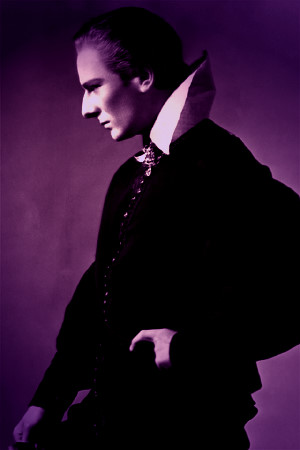
The year in which Gielgud came to grief in a Chelsea public convenience was a particularly dangerous one for homosexuals, as the increased frankness of the period allowed politicians, the police, and the press to profit by inflaming public hysteria, warning that a "plague" or "epidemic" of sodomy and Communism was sweeping the land.
The climate of fear was chilling to gay men who paid even the slightest attention to the news.
Gielgud, however, was, in his own words a "silly gubbins" who took no notice of anything outside of acting. On October 21, following the rehearsal for the play "A Day By the Sea", this supremely unworldly man, then 49, had a few drinks at a party and then visited a public lavatory popular with "cottagers" -- English gay slang for men who cruise toilets.
Arrested, and aware that he should give a false identity, he said he was a clerk called Arthur (his real name) Gielgud. The next day he appeared before a magistrate who did not know who he was, fined him 10 pounds, and ordered him, with the disdain and sexual ignorance of the period, to "see your doctor the moment you leave this court".
Unfortunately, a better-informed Evening Standard reporter was there, too. When that afternoon's paper hit the streets, he was on the front page.
You can imagine the shame and the terror with which Gielgud turned up at rehearsal (he had considered suicide) for the role of a bachelor diplomat whose mother worries that he is lonely and unloved.
But the company, led by his co-star, Dame Sybil Thorndike, in fact welcomed him with open arms. "Oh, John," she said, in one of the most magnificent double entendres of all time, "you HAVE been a silly bugger!"

The producer of "A Day By the Sea", however, the immensely powerful Binkie Beaumont, saw the newspaper articles and the hate mail, and worried that the public would stay away. Yet his thoughts of firing the star were thwarted by Gielgud's brother, Val, who applied a little judicious blackmail about Binkie's very own private life.
Although everyone was nervous that Gielgud might be greeted with silence, or even boos, on his first appearance at the play's opening, as the curtain came down he was cheered to the rafters.
Gielgud was known for having a penchant for anonymous bathroom sex -- It's one of the reasons his knighthood (just a few months before the arrest) was postponed for years. He even had a "cruising cap" for such forays, an attempt to disguise himself so as to avert detection by fans who might recognize him.
The arrest had important consequences, and not only for Gielgud, who was told by the British embassy in Washington to forget about a planned American production of "The Tempest". because he might prove "an embarrassment".
Afterwards, the floodgates opened as the public was confronted by the disturbing fact that an extremely distinguished and beloved artist was one of the people they, in theory, despised. The fuss contributed to the Wolfenden Commission, set up the following year to study prostitution, taking on homosexuality as well. Its recommendations eventually led to decriminalisation in Britain.
While the affair broke Gielgud emotionally, he put himself back together in a way that made him better suited to a theatre in a world of greater change and upheaval.
For his talent and for his courage, the Religion of Antinous honors Saint John Gielgud as a Prophet of Homoeros.
SAINT ARIAN, HIS BODYGUARDS and SAINT THEOTYKHOS
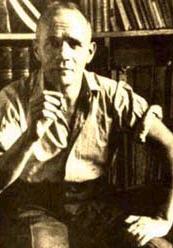
On April 15th the Religion of Antinous remembers two saints who lived in different ages and who lived in different cultures but who shared a belief that a man must be true to himself and must stick to his convictions, regardless what others demand of him.
St. Jean Genet
St. Arian, his Body-Guards and St. Theotykhos
Saint Jean Genet was one of the first and most modern gay poets, whose elegance and sordid love for the street life was unprecedented, and has never been matched.
Among his most fervent desires, expressed from the very beginning was that he should one day be elevated to Sainthood. We of the Religion of Antinous, fully and faithfully, take faith in the spirit of Saint Jean Genet, through whom the eternal voice of Antinous spoke with the most voluptuousness and vain-glory. Saint Jean Genet died on this day in Paris in1986.
Saint Arian was the governor of Antinoe, and oversaw the persecution of Christians under orders from Diocletian. He was the governor who ordered the deaths of Saints Apollonius and Philemon, whose martyrdom we observed last week. An executioner' s arrow aimed at Philemon ricocheted off his body, and shrapnel from the arrowhead blinded Arian. As he was dragged off to be drowned with his "dear friend" Apollonius, Philemon swore that Arian's eye would be restored to wholeness if he converted to Christianity at Philemon's grave and rubbed the martyr's ashes into the wound.
Arian was in fact healed and he did in fact convert to the Christian faith and was baptized together with all his household and bodyguards.
Diocletian heard of this and had Arian and his bodyguards arrested. For their faith and devotion, they voluntarily went to torture and were sentenced to death. They were cast into the river and drowned — an ironic ending for an official and his coterie who had lived in the Sacred City founded on the spot where Antinous drowned. Among the body-guards the eldest was the Martyr Theotykhos, remembered together with the other saints.
We of the Religion of Antinous recognize the mistaken zeal of the Governor Arian, who took the lives of so many Christians in our Holy City Antinoopolis.
St. Jean Genet and St. Arian were men who were prisoners of an unrelenting and intolerant age.
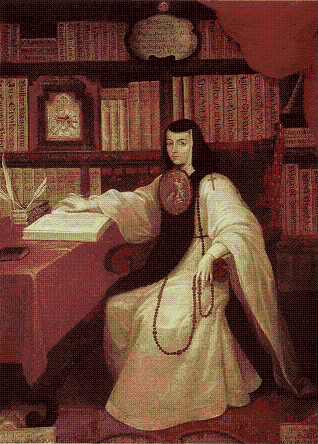
On April 17th the Religion of Antinous honors Saint Sor Juana Inés de la Cruz, 17th Century Mexican nun, scholar, poet, scientist, playwright, musician and lesbian.
She was exceptional not only for her intelligence and beauty, but also because she wrote literature centered on intellectual and sexual freedom.
In the poem "Redondillas" she defends a woman's right to be respected as a human being. "Hombres necios" (Stubborn men) criticizes the sexism of the society of her time, and pokes fun at men who publicly condemn prostitutes, among other things, but privately hire them.
She also has a philosophical approach to the relative immorality of prostitution. This was exemplified when she posed the question, "Who sins more, she who sins for pay or he who pays for sin?"
In the romantic comedy entitled "Los empeños de una casa" about a brother and a sister entangled in a web of love, she writes using two of her most prominent themes, love and jealousy.
She did not moralize, but rather, in the spirit of her lifetime interests, inquired of how these deeply emotional matters shaped and carved a woman's pursuit of liberty, knowledge, education and freedom to live her life in self-sovereignty.
Her revolutionary writings brought down upon her the ire of the Roman Catholic Church at the end of the 17th Century. She was ordered to tone down the sexuality of her writings. She did not.
However, powerful representatives from the Spanish court were her mentors and she was widely read in Spain, being called "The Tenth Muse". She was lauded as the most prominent poet of the post-conquest American Continent. Her work was printed by the first printing press of the American Continent in Mexico City.
She is believed to have penned 4,000 works, but only a few have survived. They were rescued by the Spanish Viceroy's wife, who was rumored to be her female lover. In April 1695, after ministering to the other sisters struck down by a rampant plague, she is said to have died at four in the morning on April 17th.
For her love of learning and her devotion to the beauty of sexuality and for her courage to write about controversial things in the face of the Spanish Inquisition, we honor Saint Sor Juana as a Prophet of Homoeros.
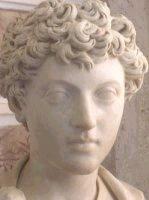
On April 26th the Religion of Antinous joyously celebrates the birth of one of the wisest rulers in history, a man hand-picked by the Divine Hadrian personally to become Emperor of Rome.
Marcus Annius Verus was born on this day in the year 121 to a Spanish Roman family, related to Hadrian. From the very start, the young Marcus showed a deep interest in learning and particularly in philosophy.
The Stoic philosopher Epictetus had the most profound influence over him, and his truthful and pious nature gained Hadrian's attention and Hadrian is said to have called him "Verissimus", or most truthful, and to have taken an interest in the future of the young philosopher.
Marcus would have been 9 years old when Antinous died, and he is not believed to have been with the court in Egypt.
When Aelius Ceasar died shortly after being chosen Emperor in 138, it is believed that Marcus was Hadrian's next choice. However, the ailing and grieving emperor felt that the 17-year-old Marcus was too young. So Hadrian decided to elect Antoninus Pius instead, requiring Antoninus to choose Marcus and the son of Lucius, called Lucius Verus, to be Antoninus's successors in turn. This became known as the Dynasty of the Antonines, the last flowering of the glory that was Imperial Rome.
Hadrian believed that the old Antoninus would only rule for the few years needed to allow Marcus to mature. But instead, Antoninus remained in power far longer than Hadrian, and Marcus was 40 years old when he at last took power.
But the Empire that he inherited was succumbing to more and more trouble along its borders, as the Germanic hordes began their slow migration across the borders. The Philosopher-King Marcus was doomed to spend the majority of his reign leading the armies along the cold northern border. He was successful in keeping the barbarians outside the Empire, and in maintaining the peace and prosperity in the heart of Rome that had been left to him by Hadrian and Antoninus. We celebrate the birthday of Imperator Caesar Marcus Aurelius Antoninus Augustus.
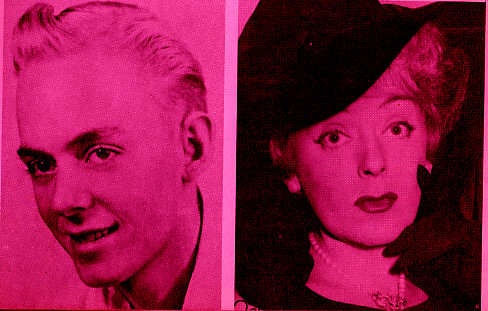
On May 3rd the Religion of Antinous celebrates the life of Christine Jorgensen, the first widely-known individual to have sex reassignment surgery. She was born May 30th, 1926, and she died on May 3rd, 1989.
Perhaps the most recognizable transsexual in the world even today, Saint Christine Jorgensen underwent male-to-female sex reassignment surgery in 1952. She went from obscurity to an onslaught of media attention, enduring many bad jokes at her expense.
But entertaining and educating, Saint Christine was a class act. Susan Stryker noted that, "Given a very narrow path to walk through life, she found a way to walk it with style."
She was banned in Boston and named Woman of The Year in New York. Interviewed later in life if she had any regrets, she replied without hesitation, "None at all."
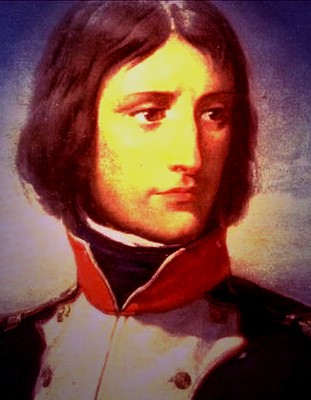
On May 5th the Religion of Antinous celebrates the life of Napoleon Bonaparte, who died on this day in 1821.
Napoleon is a saint primarily because he was the first European ruler to "decriminalize" homosexual acts. It had once been a crime punishable by burning at the stake...but Napoleon, under the advice of his top legal adviser, who was a homosexual...chose to legalize homosexuality.
He may seem a very unlikely person to be a champion of gay rights...but that's what he is...he didn't care...he saw no reason to persecute men for being homosexual...one of the greatest military commanders the world has ever known...and he accepted gay people...he would laugh at "Don't Ask, Don't Tell....he would laugh as his gay army invaded America and set things right.
Napoleon was trying to restore the Roman Empire...that's what all his imagery and symbolism were about...the fashions of the day were inspired by Rome...the Empire waist dress...women were styling their hair to look like Sabina...men combed their hair forward like Hadrian.
For gay people, one of the most disastrous turning points in world history was the defeat of Napoleon at Waterloo. We've been led to believe that the British are heroes and Napoleon was a tyrant. But he was the best "tyrant" the world has known since Hadrian.
Napoleon would have set the world forward decades or even centuries. But that didn't happen...instead of tremendous social progress...the opposite occurred.
Another reason why we Consecrate Emperor Napoleon as a Saint of Antinous is because, in 1799-1801, when Napoleon tried and nearly succeeded in conquering the entire Middle East, it was French scientists who were the last to see and the first to record and depict the remains of our Sacred City of Antinoopolis. Those ruins have vanished beneath the sands of Egypt since then.
Had Napoleon not invaded, had he not defeated the Mamluk army at the Battle of the Pyramids, then the expedition to Antinoopolis would not have occurred and the fragments of Antinoopolis would never have been recorded.

On May 10th the Religion of Antinous honors two men we call the Two Lovers of Antinoopolis who lived in the Sacred City of Antinoopolis and who worshiped the Beauteous Boy and whose joint portrait is one of the great mysteries of Egyptology.
This round portrait, called a "tondo" because of its circular format, was used as a face plate on a mummy. The vicinity of Antinoopolis and the Fayoum Oasis region is famous for hundreds of such mummy portraits which give us a priceless look at how the residents of the Sacred City actually looked. It is believed these were portraits which had hung in people's homes and which were interred with the deceased, as a reminder to their Ka about who they were in mortal life.
The tondo is unique, though, because it shows two faces. Archaeologists have no explanation as to why anyone would want the face plate on a mummy to show two men's faces. The conventional explanation is that they were perhaps brothers and when one of them died, his surviving brother insisted on burying him with their joint portrait to show his fraternal love.
But one glance at the portrait shows that the two men bear little resemblance to each other.
Even more striking is the difference in skin coloring. Throughout Egyptian art, males were portrayed as having typically ruddy-brown skin and girls and women as having creamy colored skin — that was the iconic rule in Ancient Egyptian art. The skin colors do not represent the ACTUAL skin tones of the people, just as the idealized features of pharaohs don't reflect how they actually looked.
In Ancient Egyptian art, even if two individuals appear to be identically dressed with wigs and flowing robes, you can distinguish gender roles by skin color. Ruddy skin means male. Creamy skin means female.
That makes it all the more interesting to look at the Tondo of the Two Lovers, because one man has dark "male type" skin coloring and the other man has very light "female type" skin coloring. Such contrasting skin coloring traditionally was used only for married male-female couples in Ancient Egyptian art.

Even when the hairstyles and clothing are barely indistinguishable in Egyptian art, the difference in skin tones is a gender-role clue. Any Egyptian would instantly register the visual "pun" and would think it no accident.
The artist who painted the Tondo of the Two Lovers appears to have been giving us a clue as to the relationship between the two men.
The Tondo has been dated between 130-150 AD which would place them as nearly contemporaries of Antinous, living in His Sacred City in the first bloom of the Religion of Antinous.
But of even more significance are the small images of Greco-Egyptian gods placed above their shoulders. The darker man is guarded by a figure which some experts identify as Hermanubis, a god of the underworld adored in the nearby city of Hermopolis. His name is variously interpreted as "Hermes/Anubis" or "Horus-as-Anubis", depending on whether you read the Latin or the Egyptian spellings.
The cult of Hermanubis was on the rise in Rome at this time and he was interpreted as a solar deity who (like Hermes/Mercury and Horus) led the dead through the darkness to everlasting sunlight. A crack runs through the figure, however, making its identity somewhat unsure. At one point Hermanubis had a large cult following in Rome itself and his face graced Imperial coins. But his cult was suppressed almost as quickly as it rose, for moralistic reasons which are hard to reconstruct.
The lighter skinned and more beautifully dressed boy is watched over by Antinous, the patron god of Antinoopolis, who grasps a Dionysiac scepter and who wears the SWTY (Two Feathers) crown of divinity symbolic of his many-faceted Sacred Powers. It is ironic that the Christians later suppressed the cult of Antinous for moralistic reasons, just as the cult of Hermanubis had been suppressed by the Romans. Was there a sexual/moral connection between the two cults?

At any rate, this makes the Tondo of the Two Lovers the only portrait painting of Antinous to have survived, and the only image of two probable followers of HIS religion.
The faint inscription beneath the image of Antinous reads 15 Pachon, which is a date in the Greek calendar that corresponds to the 10th of May. No one knows what the significance of this date might be. An anniversary, perhaps.
The younger figure is wearing a splendid red wrap held in place by an impressive amethyst brooch in a gold setting — a family heirloom perhaps. The artist has gone to pains to render it perfectly. The embroidery on his white tunic is very fine. An oriental swastika good-luck charm is stitched into his right sleeve.
Perhaps the portrait was commissioned for the day (May 10th) when he donned his manly robes for the first time on his 16th birthday, as was the Roman custom. The peach-fuzz on his face gives him the appearance of an adolescent.
The older man (who could 30-something) stands behind him, as if symbolically showing his love and support of his young companion. He could be an older brother or uncle. He could even be the youth's father — life expectancies were shorter then, and people married early in those days and were grandparents by their mid-30s.
But just perhaps the composition and skin-tone nuances are subtle clues by the artist that these two men shared an older-man, younger-man relationship — a Classical Greek-style erastes/eromenos relationship — similar to that of Hadrian and Antinous. After all, this city was founded on Hadrian's love for Antinous.
The Religion of Antinous honors these two men on May 10th — the day which was so special to them, for reasons known only to them and to the gods they worshiped — Hermanubis and Antinous!
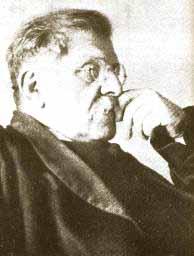
On May 14th, the Religion of Antinous honors the life of the Father of Gay Liberation, Doctor Magnus Hirschfeld, who died on this day in 1935 (which was his 67th birthday) while in exile form his native Germany in Nice, France. He died a broken and embittered man.
A life that had started out with such lofty ambitions ended in disillusionment. He was of Jewish ancestry and began his career as a medical doctor but very soon devoted his life to the study of homosexuality.
In 1897 he founded the Scientific Humanitarian Committee, which was an organization whose publication, called The Yearbook of Intermediate Sexual Types, was devoted to the repeal of "Paragraph 175", a law passed by the Reichstag in 1869.
The work of the committee included ongoing lobbying supported by the scientific studies of Dr. Hirschfeld into human sexuality. This study culminated in the formation of the Institute for Sexual Science in 1919.
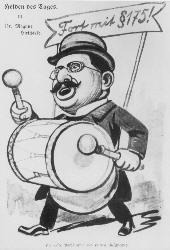
Dr. Hirschfeld spent the majority of his career writing and lecturing around the world on the nature of homosexuality and other "intermediate" sexual types, including cross dressers. The word "transsexual" was coined by Dr. Hirschfeld to describe the phenomenon that he argued was a natural extension of human sexuality.
His philosophy centered on the contention that there was a third sex, called the Uranian, which was neither male nor female, but a combination of both that was manifested in homosexuality, which was not to be considered an impure deviation, or even as an illness, but as a natural and phenomenal component of human nature.
For his work, the Nazis targeted Dr. Hirschfeld as an example of decadent Bolshevistic/Jewish influence infecting the purity of the German people, luring the Aryan race into impure and destructive perversity. He was ultimately driven into exile and burned in effigy as an emblem of evil. His institute was ransacked May 6th and his books were publicly burned in a bonfire on May 10th, 1933.
The slogan with which he began his speeches, "Uranians of the World, Unite!" was not to be realized until our own time. For his courage and his career of some thirty years, all of which was spent in tireless devotion to the cause of Gay Liberation, we venerate Saint Magnus Hirschfeld.
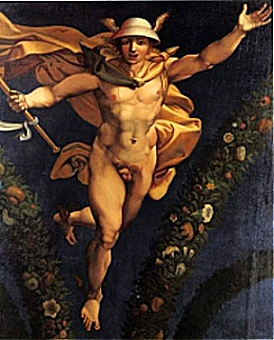
We lift up our hearts to the great wing-footed God Mercury on this day. Father of Antinous, son of Zeus and Maia.
Mercury is the god of speed, the Lord of commerce, communication, and cunning. He is forever young and beautiful, the patron of skilled athletes, especially runners, and yet he possesses the infinite wisdom of extreme old age.
When Mercury was one day old, he charmed Apollo by stealing the sun god's prized cattle and crafting an ingenious story to cover his tracks.
Apollo fell in love with Mercury and from that day forward became his godfather and protector, presenting him to Olympus. Zeus was so taken by his son Mercury that he made him the messenger of the gods, and placed in his hand the sacred Caduceus, the serpent-entwined rod.
.jpg)
Hermes (as he was called by the Greeks) was charged with escorting the souls of the dead to the underworld, and to relay messages between heaven and hell. Thus he acquired his mystic powers, which were the inspiration of the Hermits, and of their religion known as Hermeticism.
He was known to them as Hermes Tristmegistus, the "thrice-great", and was said to have taught the secret knowledge of salvation to mankind.
As Hermes of the crossroads, he was a Phallic god, whose image was a herme, or column with a bearded head and a large penis that was placed at forks in the road to protect travelers.
Mercury made love to Venus and was father of Pan, Priapus, Hermaphroditus, and of Fortuna. He was the craftiest inventor, who created the lyre, which he gave to Apollo. And he invented written language, weights and measurement.
Mercury was the god of good business, but also of dishonesty and absolute capitalism. He invented dice and was the lord of gambling and all games of chance.
Antinous was often compared to Mercury in the statues and in the artefact fragments. His powers of youth, virility and physical fitness were central parts of the Religion of Antinous. But the hermetic sages, from whom so much of the salvation of Antinous extends, deepened this fascade. He is, along with Dionysus, Apollo and Osiris, a major facet of the Spirituality of Antinous.
We acknowledge and extol Mercury, the wing-footed god, and pray to him as Antinous to run by our side and give us good fortune throughout our travels and in our communication with the divine.

On May 19th, the Religion of Antinous honors our Saint Peter Wildeblood, a British journalist, novelist, playwright and gay-rights campaigner, who was born on this day in 1923.
He became one of the first men in Britain to declare publicly that he was gay, when he was arrested and put on trial in a headline-making case in 1954. He was sent to prison on a conviction of "conspiring to incite acts of gross indecency and buggery" and his case created such an uproar that it helped to lead to the 1960s reform of anti-gay laws in the UK.
In the uptight post-war years of the early '50s, Wildeblood had made something of a name for himself in the theatre and as a roving reporter for a major newspaper, London's Daily Mail, when he happened to meet a 23-year-old RAF corporal named Eddie McNally in Piccadilly Circus. Although Eddie McNally was not Peter Wildeblood's type, they developed a relationship over time. In the summer of 1952 they arranged to go on holiday together at Edward Montagu's beach hut on the English coast. John Reynolds, who was also an airman and a friend of Eddie McNally, also joined them.
About 18 months later, on Saturday, January 9, 1954, Peter Wildeblood was arrested at his home and his house was searched. He was charged with conspiring with Edward Montagu and Michael Pitt-Rivers to incite Eddie McNally and John Reynolds to commit indecent acts.
The police tipped off the press and the story was headlined in all the Sunday newspapers the next day. Eddie McNally and John Reynolds became witnesses for the prosecution.
The media went on a feeding frenzy and his picture was plastered all over the front pages for weeks. One paper retouched his photos to make it appear that he was wearing lipstick. He was vilified in public. He later described one incident when a woman recognized him being driven past in a vehicle.

"That night, a woman spat at me," Wildeblood wrote later. "She was a respectable looking, middle-aged, tweedy person wearing a sensible felt hat. She was standing on the pavement as the car went by. I saw her suck in her cheeks, and the next moment a big blob of spit was running down the windscreen.
"This shocked me very much. The woman did not look eccentric or evil; in fact she looked very much like the country gentlewomen with whom my mother used to take coffee when she has finished her shopping on Saturday mornings. She looked thoroughly ordinary, to me. But what did I look like to her? Evidently, I was a monster."
What so troubled the decent people of the day was not that homosexual practices went on — everybody knew they always had and always would — but that anybody would openly declare himself to be "a homosexual."
He was in the news constantly until his conviction and sentencing to 18 months in prison. Because he was (understandably) depressed, he was considered suicidal and was transferred to a dire hospital for the criminally insane where the squalid conditions affected not only his mental health but also his physical health.
He was released after 12 months and immediately launched a personal crusade to overturn anti-gay sex laws in Britain. He lobbied in Parliament and wrote articles and a book entitled Against the Law which outlined how gay people can be entrapped and harassed in their own homes for consensual activity among adults which does not affect anyone else.

His three main points were that homosexuality between consenting adults in private ought not to be against the law, that prison only encourages homosexuality, and that in the squalor of prison hospitals there was no attempt at rehabilitation. While writing this he bought a small drinking club in Soho which attracted a mixture of types on the fringes of society. This provided material for his fictional autobiography about the club, A Way Of Life.
It was a surprise success and encouraged him to write more novels and plays which were hits on stage in London's West End in the late 1950s. In the '60s he became a well-known TV scriptwriter and producer. In the '70s he was lured by Canadian television with a lucrative contract, and emigrated to Canada, where he adopted Canadian citizenship and was responsible for numerous hit productions over the next 16 years.
When he retired in the 1980s, he went to live in a wooden Edwardian cottage in Victoria on the western coast of Canada which had a stunning view over the Juan de Fuca Straits to the Olympic Mountains above Seattle. He suffered a series of debilitating strokes in the mid-'90s which left him speechless and quadriplegic. He learned to communicate via a computer using movements of his chin. He suffered a final stroke and died November 13, 1999, at the age of 76.
In saluting Saint Peter Wildeblood, the Religion of Antinous honors the beacon of courage and hope which he represented in an age of darkness and despair for gay men everywhere. Everyone advised him to remain quiet, and yet he chose to speak out. He did not choose to be exposed but, placed at the mercy of events, he chose to become their master.
His book was a courageous act of defiance against the kind of injustice which the straight world called justice.
"Very faintly," he wrote, "as though at the end of a tunnel, I could see what I must do. I would make a statement ... I would simply tell the truth about myself ... I would be the first homosexual to tell what it felt like to be an exile in one's own country. I might destroy myself, but perhaps I could help others."

On May 26th the Religion of Antinous celebrates the life of Reg "Regina Fong" Bundy, a blessed saint of Antinous, who was born on this day in 1941 and died on April 15, 2003. A brazenly gay cabaret artiste — she disliked being called a drag queen — she was a well-known AIDS charity host who influenced a generation of post-Stonewall gays in Britain with acerbic send-ups of politics and popular culture.
Regina Fong was not just a "queen", she was an "empress" — the last of the Russian Imperial Dynasty of the Romanoffs. Forget Anastasia (and Ingrid Bergman in a '50s film), Regina Fong was the REAL heir to Russian nobility. Like so many Russian aristocrats, she sought asylum in monarchical Britain after the Russian Revolution. There were indeed members of the Russian Imperial family who lived (albeit rather modestly) on the grounds of Windsor Castle during the 20th Century. Empress Regina lived (albeit rather immodestly) in London's West End.
Her Imperial Highness (HIH) Regina Fong did in fact become an Iconic cult figure on the European Cabaret stage. Known to friends as Reg (pronounced "Redge"), she lost her battle to cancer April 15, 2003.
But Reg, by creating Her Imperial Highness Regina Fong, a flame-red-wigged champion of gay rights, was insistently committed to being the knight in shining red armour who carried the banner of charities involved in transforming the AIDS epidemic from mortal tragedy into spiritual triumph. She reminded us all that gay cabaret, especially in London at that time, was (and continues to be) a central part of gay life.
After the "Gay Liberation" in the late '60s and '70s, drag queens and cabaret artistes were pushed to the back of the room, to more mainstream, homogenized images of gay life.
Regina Fong, and other Gay pioneers like Lily Savage, changed this forever and brought Gay Cabaret back to its rightful spot in the London Gay Scene. The Cabaret Tent at London Gay Pride events as the epicenter of Gay culture in good times and bad is the direct legacy of this valiant drag queen — er, ahm — cabaret artiste!
Our own Knight Stephanos personally knew Empress Regina Fong and conferred with her often in the legendary Black Cap gay bar in the heart of the West End Theatre District of London. And so it is fitting that Knight Stephanos (pictured right with Her Imperial Highness) explains her Sacred Significance to us:
"Reg Bundy and his creative spirit, through HIH Regina Fong, reminded us all that we mattered as gay people, that we mattered, and that being just who we were was were our strength laid as a culture.
"I knew Regina Fong between the years of 1989 and 1995, a time when contracting the HIV Virus was a virtual death sentence. We witnessed scores of wonderful gay men fall to aids. Regina Fong (and more importantly his non-drag persona Reg Bundy) was a pillar of hope with his sarcastically witty way of keeping up stiff-British-upper-lips during some incredibly dark times.
"If Reg could keep up a brave face in such a scary time, then all was not lost. I had many conversations with Reg in the old front bar at the Black Cap. Surrounded by the dregs, gutter street characters and top-notch West End talent that would congregate, Reg held court and parlayed the latest gossip and told stories of how it was to be gay in London before it was legal.
"He was a Romantic at heart, a Dreamer and a Bitch, who always left you with something to think about, cry about or laugh about. There are many things that are a fog to me about London in those far-off days. But Reg Bundy I always remember as clear as a bell.
"I assumed Reg would live for ever. It is surreal to me that he is gone, But I know his spirit lives on, looking down from some corner of the Black Cap and many other pubs in London, and even right here in Hollywood, California, keeping watch and holding court, drinking vodka-and-tonic — being a beacon in dark times — and a Gay Saint Always."
HER IMPERIAL HIGHNESS REGINA FONG
BY KNIGHT STEPHANOS KILGORE
White Empress
Flame of red
Exiled royalty
Last of the Romanoffs
Gay Icon
Cult following
Every Tuesday night
Vodka and a smile
Sharp tongue
Quick wit
Black Cap
Manic queen of cabaret stage
Artist
Hero
Regina Fong
Reg
Holding court
Saturday morning
Friend to all
Regal
Always real
Fong
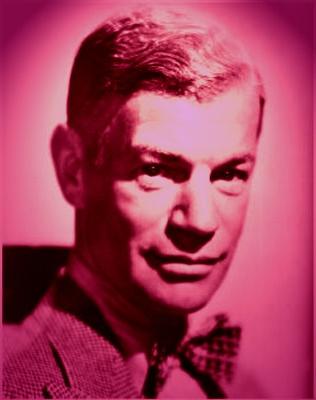
On May 29th the Religion of Antinous celebrates the life of Saint James Whale (22 July 1889 — 29 May 1957), the openly gay British-born director of such films as Frankenstein, The Old Dark House, Bride of Frankenstein and The Invisible Man.
His movies were modern parables about the cruelty of "normal" people towards "monsters" in their midst.
All of those 1930s films are recognized as classics of the genre. Whale directed over a dozen films in other genres, including what is considered the definitive 1936 film version of the musical Show Boat.
He became increasingly disenchanted with his association with horror, but many of his non-horror films have fallen into obscurity. Whale was openly gay throughout his career, something that was very unusual in the 1920s and 1930s.
He tended to use gay actors who were friends of his, including Colin Clive, Ernest Thesiger, Charles Laughton and Laughton's wife Elsa Lanchester, who played the "Bride". Thesiger has tea (below) in mad-scientist garb.
Bride of Frankenstein, in particular, is widely interpreted as having a gay subtext and it has been claimed that Whale's refusal to remain in the closet led to the end of his career.
James Whale's true genius was in making movies which made the audience sympathize with the "monster" instead of the "normal" people, who invariably were portrayed as ridiculous, comic fools.

James Whale's soaring career was dashed by homophobic studio bosses who objected to having a "pansy" directing major movies. He spent the last decade of his life as an outcast in Hollywood.
He "accidentally" drowned in his own swimming pool in the mid-1950s after having become a chronic depressive following a stroke.
His life was brought to the screen in the award-winning movie Gods and Monsters, which is a masterful adaptation of a very wonderfully written gay novel entitled Father of Frankenstein by Christopher Bram.
The book and the movie are about his final weeks of life with flashbacks to his childhood in poverty in northern England and his traumatic experiences during World War I and to his heyday as the toast of Tinseltown, and his plunge into obscurity — and his final plunge into the watery arms of Antinous.
It is a great irony that the only out-and-proud Hollywood director of the 1930s is remembered as a man whose name is equated with monsters.
Sir Ian McKellen, who is also from conservative Northern England and is an openly gay star of stage and screen, was nominated for a Golden Globe and for an Academy Award for his role as James Whale in the 1998 movie Gods and Monsters.
Brendan Fraser also won critical acclaim in that film as Whale's yard boy who identifies with the Frankenstein monster. His compelling portrayal suggests to the audience that all of us are gods and monsters, to some degree. But then, even Antinous was a god to pagans — yet a monster to early Christians.
And Lynn Redgrave won a Golden Globe and got an Oscar nod for her scene-stealing performance as James Whale's disapproving Swedish housekeeper — a tongue-in-cheek characterization drawn from the real-life eccentrics who performed supporting roles in Whale's wonderfully campy old movies.
TO A NEW WORLD OF GODS AND MONSTERS!
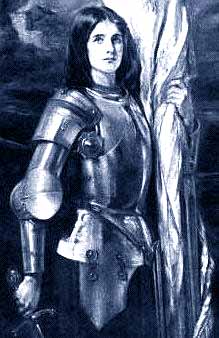
On May 30th the Religion of Antinous honors Saint Joan of Arc who was burned as a heretic on this day in 1431.
She was a peasant girl who led the armies of the King of France against the occupying forces of the English. She claimed to have been chosen by God to drive the English from France and deliver the country to her King.
Joan of Arc said that she conversed daily with Saints Catherine and Margaret and St. Michael the Archangel. Her greatest victory was the liberation of Orleans, where Charles, then Dauphin, was crowned as King of France.
She was later captured by the English and subsequently tried by the Church and burned as a heretic. The focus of her trial was upon the nature of her visions, which the inquisitors condemned as Demonic, and upon her refusal to wear women's clothing.
Joan of Arc was in essence the most courageous of all transvestites, whose insistence upon male dress and hair style, and occupation as a warrior was the excuse used by the Church for her condemnation and subsequent burning as a heretic. The Church however reversed this decision in 1909 by beatifying her, and then finally consecrating her as a saint in 1920.
Though she is a saint of the Catholic Church and a devoted Christian, it is for her courage as a transvestite and possibly as a sacred lesbian that she is included as a Heroic Martyr Saint of Ecclesia Antinoi.